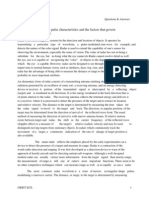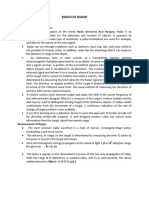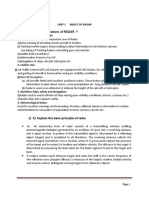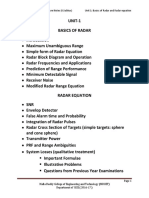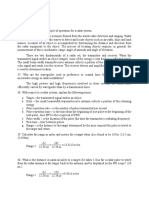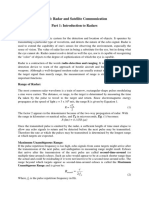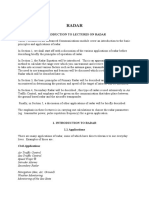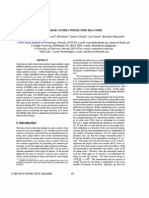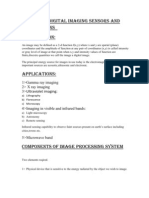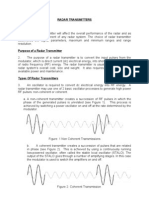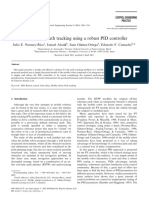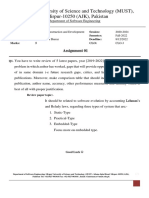Physics Individual Study
Physics Individual Study
Uploaded by
liam_carmody3970Copyright:
Available Formats
Physics Individual Study
Physics Individual Study
Uploaded by
liam_carmody3970Original Description:
Copyright
Available Formats
Share this document
Did you find this document useful?
Is this content inappropriate?
Copyright:
Available Formats
Physics Individual Study
Physics Individual Study
Uploaded by
liam_carmody3970Copyright:
Available Formats
Physics Information Search
RADAR Systems and Electronic Warfare
[Type the abstract of the document here. The abstract is typically a short summary of the contents of the document. Type the abstract of the document here. The abstract is typically a short summary of the contents of the document.] Liam Carmody 6/6/2010
Physics Information Search
RADAR Systems and Electronic Warfare
Question
What are the limiting factors that a RADAR system encounters, and how are these limits calculated? Additionally, what forms of RADAR counter measures are used in stealth aircraft?
Introduction
RADAR, standing for RAdio Detection And Ranging, makes use of pulsing radio signals that can detect foreign objects. In warfare, the early detection of enemy aircraft can be integral to defending effectively against attacks. As such, WWII saw RADAR systems emerge quickly into functioning warfare devices. Whilst there are many different types of RADAR systems, this report will focus on the most common, the Monostatic Pulse Radar.
RADAR Principles
The system itself relies on the fact that radio waves are reflected from surfaces; waves of a specific frequency can be created and sent out as a pulse. When the wave hits a surface, such as that of an aeroplane, the wave will be reflected in many directions. The RADAR system then will listen for a return fraction of that wave; from this the distance to the detected object can be calculated. The direction can be found due to the rotating motion of most systems; the RADAR itself will rotate around a base, hence sweeping a full 360 portion of the sky. Altitude (in simple systems) can be estimated by the variation in amplitude of the returned signal.
Calculating Distance
The initial distance that is calculated by the RADAR system is known as the slant range, this is the distance measured of a line of sight path to the object, the ground distance requires the knowledge of the elevation of the object. The equation used to find the slant range can be derived from the following: where s= distance, v = velocity and t= time for response; Because the time for the response includes the returning distance, the total displacement is 2R where c= speed of light (3x108 m/s) and R= Slant Range
Liam Carmody Page 2 of 10
Year 12 Physics Information Search
The speed of light (in a vacuum) is used, as this is the speed at which all electromagnetic waves propagate.
Limitations of the Monostatic Pulse RADAR
A RADAR system has several limitations to its effectiveness including the maximum range and where it is situated. Maximum range is obviously the largest limitation; this can be obtained through the examination of several formulae which then can be resolved into what is known as the Radar Equation to calculate the theoretical maximum range of any given RADAR system. There are several limiting factors that must be taken into account for any RADAR system, these are related in the RADAR equation, which will be built up in the following discussion. They are as follows and are explained in further detail further on: The Pulse Repetition Frequency The transmitting power The wavelength of the transmitted signal The Antenna Gain
Firstly the system has a maximum ambiguous range that it can operate at. This ambiguous range is determined by the length of time between each pulse, as the system must switch from transmitting to receiving modes and vice versa for each pulse, the returning signal only has so long to reach the RADAR before it has switched to transmit the next pulse. The maximum ambiguous range can be calculated with the following formula;
This is where: Rmax = the maximum ambiguous range (metres) c= the speed of light (3x108 m/s) PRT = the intrapulse period (i.e. the time between each pulse in seconds) o This can be calculated using the PRF; Pulse Repetition Frequency, that is, how many pulses are sent out per second. The PRT is simply calculated by 1/PRF. Pw = the pulse width (the length of time in seconds of the actual pulse itself, assuming that the entire pulse must be received to detect an object. As the RADAR is constantly rotating, this gives the pulse a width)
Similarly, RADAR systems also have a minimum range; this is due to the actual transmission of the pulse. As the system cannot receive any responses during this time, a minimum detection range occurs. This can be calculated with the following formula;
Liam Carmody Page 3 of 10
Year 12 Physics Information Search
This is where: Rmin = the minimum detection range (metres) c= the speed of light (3x108 m/s) tpw = the transmitting time (seconds) Trecovery = the length of time it takes the system to switch over completely to receiving mode.
Due to the geometric spreading of power as the wave travels further away (in free space), the receiving ability of the antenna also limits the range of the system.
Diagram of geometric spreading, note that the same power has to cover a larger area the further away from the source. (Wolff, 2008)
As the energy will spread equally in all directions, areas with the same power density form spheres, as such the area is given by . The Free Space Power Loss (FSPL) can be calculated by a combination of two formulae, the first formula finds the power per unit area at a given distance;
This is where: S = the power per unit area (at a distance) in Watts per meters squared (Wm-2); for a given case this is the Non-directional power density. PT = Transmitted power in Watts (W) R = Distance between the transmitter and receiver in metres (m)
The second formula calculates the antennas aperture, which describes how well the antenna can receive power from an electromagnetic wave. This is given by the following formula;
Liam Carmody Page 4 of 10
Year 12 Physics Information Search
This is where: Pr = The received power in Watts (W) S = The non-directional power density, this is the power per unit area of the signal(calculated above) = Wavelength of the signal.
By combining these formulas we obtain the formula for FSPL, which is the ratio that Pt divides Pr This FSPL represents the antenna's ability to receive signals as the distance between the object and antenna increases.
This is where: The symbols used in the above equations still stand f= frequency C = the speed of light in a vacuum (3 X 108)
Finally, the Radar Equation can be found by combining these equations with some alterations; The Non directional Power equation found above can be made more accurate by taking into account the gain of the antenna. Gain is achieved by altering the shape of the emitted pulse using specific antennas (such as a parabolic antenna) to achieve a higher power output in one direction. From this we can say that Directional power is given by,
Where: Pr = Reflected (Directional) Power in Watts (W) Ps= Transmitted power in Watts (W) G= Antenna Gain (given by the directional power divided by the non-directional power density (Sg/Su) = Radar cross section in m2 Liam Carmody Year 12 Physics Information Search Page 5 of 10
R = Distance between antenna and object (aim)
Since the echoes are affected by the same conditions of the transmitted power discussed above, we can say that the received power density received is given by:
Where: Se= Power density at receiving place Pr = Reflected (Directional) Power in Watts (W) R = Distance between object(aim) and antenna
The real received power, however, is affected by the antenna aperture, Aw (m2). The aperture is calculated using the Area of the antenna multiplied by the efficiency rate. In general, the efficiency is around 60% - 70% (0.6 - 0.7 Ka) . Using this the final received power is given by:
We then can combine both the receiving and transmitting power equations into a singular form: Using, and We can derive that:
Another equation for Antenna Gain can be rearranged for A in order to substitute,
Liam Carmody Page 6 of 10
Year 12 Physics Information Search
After substitution and simplification, the equation for Pe reads:
Continued on next page.
and by solving for R we get the Radar equation; This is the basic RADAR equation which will give an approximation of the maximum theoretical range of a given system (note that this occurs when Pe is at its minimum). This is not completely accurate as it assumes that all waves have propagated under ideal conditions, further refinements can be made to the formula to take this into account by using the loss factor which includes the following possible losses:
L D = internal factors of the radar set on the transmitting and receiving paths L f = fluctuation losses during the reflection (i.e. the object being smaller than the wavelength will cause interference with the reflected waves.) L Atm = atmospheric losses during propagation of the electromagnetic waves to and from the target
In addition, an extended formula that is sometimes used takes into account the earth's surface:
Liam Carmody Page 7 of 10
Year 12 Physics Information Search
The RADAR equation with many more factors taken into account, giving a more accurate estimate of the maximum range. Note that this equation also does not take into account loss factors as discussed above. (Wolff, 2008)
Counter-RADAR techniques
Stealth aircraft are usually designed with RADAR countermeasures in mind. The most common and effective method is within the shape of the aircraft. To reduce the radar cross section of the aeroplane, the surfaces of the aircraft are designed as such that they do not reflect radio waves back in their original direction. Surfaces are generally designed so that the they are nearly always as close to tangential from the direction of RADAR pulses. The idea is to minimise the cross section of the returned pulses to such an extent that the aircraft cannot be detected.
The SR-71 "Blackbird", one of the first operating aircraft designed using stealth principles in mind. Note the shape of the aircraft used to minimise reflected RADAR signals.
The F-35 "Lightning", the newest fighter for the USAF and RAAF, note that this aircraft relies heavily on RAM (Radar Absorbent Materials) to counteract RADAR, rather than shape.
Liam Carmody Page 8 of 10
Year 12 Physics Information Search
In addition, under the surface of the plane, a structure of "re-entrant triangles" are sometimes used to reduce the power of the reflected signals. Re-entrant triangles are a series of inverted pyramids, such as one might see in a soundproof room. This works by effectively trapping the electromagnetic waves within the inverted pyramid like structure so it will lose its power over time and when it is eventually reflected back to the antenna, the power loss is so great that the RADAR station is unable to detect the object (or if it does, it cannot be distinguished between smaller objects such as birds or light aircraft.) Radar Absorbent Materials (RAM), are materials used to coat stealth aircraft in order to reduce the RADAR signals that are reflected. These materials often are made of substances that instead of reflecting electromagnetic waves, they convert them to heat energy, which then can be dissipated over the body of the aircraft. One such example is "Iron Ball Paint", which is made up of small spheres coated in Carbonyl Iron, electromagnetic waves cause the molecular structure to oscillate causing the conversion of energy into heat. In order to confuse the enemy, active systems can be employed that cloud the RADAR systems. That is, electromagnetic pulses are generated by a 'friendly' aircraft so to "jam" the enemy's RADAR systems. This type of jamming usually comes from a single, high altitude communication aircraft, rather than individual fighters or bombers. As such, this method is used in large scale attacks more so than precision missions and is not used often in modern warfare.
Conclusion
Through the research and gradual development of WWII concepts, RADAR has developed into an extremely useful tool in warfare. As in all technology developed in war, counter measures are developed almost equally as fast to regain an advantage. The RADAR system has greatly grown in complexity since the initial systems, however the basic principles still apply, and the limitations are generally the same. While new developments are made to overcome these limitations, existing formulae such as the RADAR equation can also continue to develop for all new systems. RADAR continues to be integral to warfare and will continue to do so as the technology develops.
Works Cited
Anon., 2008. Stealth Design of Airplanes. [Online] Available at: http://www.fighterplanes.com/stealth.htm [Accessed 06 June 2010]. Neri, F., 2001. Introduction to Electronic Defence. Artech House. Liam Carmody Page 9 of 10 Year 12 Physics Information Search
Schleher, D.C., 1999. Electronic Warfare in the Information Age. Artech House. Wolff, C., 2008. RadarTutorial.eu. [Online] Available at: http://www.radartutorial.eu/index.en.html [Accessed 01 June 2010].
Liam Carmody Page 10 of 10
Year 12 Physics Information Search
You might also like
- Tuttnauer 66120-1VEPDocument135 pagesTuttnauer 66120-1VEPErick Jr Cardozo Romero100% (1)
- Software Requirement SpecificationDocument7 pagesSoftware Requirement SpecificationSiri Kranti50% (2)
- Group 5&6 Radar Systems - NaviDocument9 pagesGroup 5&6 Radar Systems - NaviDaniel TamisenNo ratings yet
- Radar Unit 1Document60 pagesRadar Unit 1GAURAV RATHORENo ratings yet
- Yyyy Y Yy YDocument28 pagesYyyy Y Yy Yrajanikanth_rNo ratings yet
- RS Unit-1pptDocument83 pagesRS Unit-1pptNamadi SwethaNo ratings yet
- RadarDocument16 pagesRadarACLINNo ratings yet
- Lecture VIDocument61 pagesLecture VIAhmed WasiuNo ratings yet
- Basic Radar System Block DiagramDocument9 pagesBasic Radar System Block Diagrambapiraju saripellaNo ratings yet
- Microwave FMCW RadarDocument48 pagesMicrowave FMCW RadarPranabKumarGoswami100% (2)
- Extracted Pages From RADAR SYSTEMS - Unit-1Document31 pagesExtracted Pages From RADAR SYSTEMS - Unit-1Mahendar ReddyNo ratings yet
- 1.what Are The Desirable Pulse Characteristics and The Factors That Govern Them in A Radar System?Document10 pages1.what Are The Desirable Pulse Characteristics and The Factors That Govern Them in A Radar System?allinonemp3_comNo ratings yet
- Microwave Communications and Radar: Target Scattering Cross-SectionDocument6 pagesMicrowave Communications and Radar: Target Scattering Cross-SectionOmotowa DapoNo ratings yet
- Introduction of RadarDocument32 pagesIntroduction of RadarSaurabh KatiyarNo ratings yet
- Radar Principles & SystemsDocument57 pagesRadar Principles & Systemssmskaushik1No ratings yet
- Radar Engineering Assignment KeyDocument24 pagesRadar Engineering Assignment KeySree VamsiNo ratings yet
- Radar SystemsDocument108 pagesRadar Systemssunanda100% (1)
- Prinsip RadarDocument29 pagesPrinsip RadarRahmad Satriya WibawaNo ratings yet
- 202004021910156883ajay Misra Geo MicrowaveDocument13 pages202004021910156883ajay Misra Geo MicrowaveshashivrceNo ratings yet
- Surveying Mod5 Modern Surveying InstrumentsDocument81 pagesSurveying Mod5 Modern Surveying InstrumentsAkshay KayapakNo ratings yet
- Miller QuestionDocument3 pagesMiller QuestionjohnnyNo ratings yet
- Principles of Active Remote Sensing: Radars.: ObjectivesDocument9 pagesPrinciples of Active Remote Sensing: Radars.: ObjectivesShubhra MathurNo ratings yet
- Radar Viii Sem EceDocument8 pagesRadar Viii Sem Ecennidhu890No ratings yet
- Weather RadarDocument4 pagesWeather RadarMuhammadHammadNo ratings yet
- Radar: - What Is RADAR? - Cathode Ray Tube - Time BaseDocument25 pagesRadar: - What Is RADAR? - Cathode Ray Tube - Time BasevishwaaskNo ratings yet
- Introduction To RadarsDocument4 pagesIntroduction To RadarsSivaranjan GoswamiNo ratings yet
- Radar and Sensor Systems Basic Principle of OperationDocument16 pagesRadar and Sensor Systems Basic Principle of OperationJeff Mirondo KibalyaNo ratings yet
- (Radar) Lecture NotesDocument48 pages(Radar) Lecture NotesAli AL-KHAYYATNo ratings yet
- T, Then The Range May Be Determined by The SimpleDocument5 pagesT, Then The Range May Be Determined by The SimpleSathiya NarayananNo ratings yet
- Friss Transmission EquationDocument6 pagesFriss Transmission EquationumarNo ratings yet
- Radar SystemsDocument15 pagesRadar SystemsrallabhandiSKNo ratings yet
- RadarDocument12 pagesRadarAhmed RashadNo ratings yet
- Principles of Synthetic Aperture RadarDocument12 pagesPrinciples of Synthetic Aperture RadarciaobubuNo ratings yet
- Radar PerformanceDocument8 pagesRadar PerformanceMani VrsNo ratings yet
- Eee 445 IDocument10 pagesEee 445 IIdrisa MusaNo ratings yet
- Antenna Measurement: Antenna Measurement Techniques Refers To The Testing of Antennas To Ensure That The AntennaDocument8 pagesAntenna Measurement: Antenna Measurement Techniques Refers To The Testing of Antennas To Ensure That The AntennaDiwakar MishraNo ratings yet
- Rna MaterialDocument147 pagesRna MaterialShivani SaxenaNo ratings yet
- MIMO Radar A Idea Whose Time Has ComeDocument8 pagesMIMO Radar A Idea Whose Time Has Cometrongnguyen29No ratings yet
- Wa0002 PDFDocument21 pagesWa0002 PDFDevendra VarmaNo ratings yet
- Ch1 Introduction+to+Radar+SystemsDocument70 pagesCh1 Introduction+to+Radar+SystemsWesley GeorgeNo ratings yet
- Air Traffic Control and Airport Design UNIT 3Document48 pagesAir Traffic Control and Airport Design UNIT 3Prof L. OblisamyNo ratings yet
- Chapter 1: Introduction: The Name Radar Stands For Radio Detection and RangingDocument37 pagesChapter 1: Introduction: The Name Radar Stands For Radio Detection and RangingrajeevNo ratings yet
- Abstract: Ý Tal A Sesors Aý Appl Cat Os Troýct O:: 1 Camma Ray Imaging 2 C X Ray Imaging 3 C CDocument7 pagesAbstract: Ý Tal A Sesors Aý Appl Cat Os Troýct O:: 1 Camma Ray Imaging 2 C X Ray Imaging 3 C CPandit StrangerNo ratings yet
- 1.0 Radar Basics: Skolnik, M. I., Introduction To Radar Systems, Third Edition, 2001, Mcgraw-Hill, New York, N.YDocument12 pages1.0 Radar Basics: Skolnik, M. I., Introduction To Radar Systems, Third Edition, 2001, Mcgraw-Hill, New York, N.Yiremulku1046No ratings yet
- What Is Radar and How Is It UsedDocument73 pagesWhat Is Radar and How Is It UsedAhmed ShahNo ratings yet
- Basics of Radar EMTDocument7 pagesBasics of Radar EMTSHASHANK AGRAHARINo ratings yet
- Radar :radio Detection and Ranging Seminar ReportDocument18 pagesRadar :radio Detection and Ranging Seminar ReportRavindra Mathanker89% (9)
- Principles of Synthetic Aperture Radar: Surveys in Geophysics January 2000Document13 pagesPrinciples of Synthetic Aperture Radar: Surveys in Geophysics January 2000naveen narula100% (1)
- Radar Transmitters and 2Document8 pagesRadar Transmitters and 2mas3565560No ratings yet
- Tutorial ProblemsDocument11 pagesTutorial ProblemsMani VrsNo ratings yet
- Unit-I: Introduction To RadarDocument17 pagesUnit-I: Introduction To Radarraza sulemanNo ratings yet
- An Overview of Microwave Sensor TechnologyDocument8 pagesAn Overview of Microwave Sensor Technology박철승No ratings yet
- RT-CH 3 - CW and Frequency Modulated RadarDocument18 pagesRT-CH 3 - CW and Frequency Modulated RadarHemant YadavNo ratings yet
- Radar Systems - Unit1Document129 pagesRadar Systems - Unit1srinivasanaikNo ratings yet
- Wireless Communication Engineering (Fall 2004) : Professor Mingbo Xiao Nov. 11, 2004Document39 pagesWireless Communication Engineering (Fall 2004) : Professor Mingbo Xiao Nov. 11, 2004Sameer SalamNo ratings yet
- Group ViiiDocument7 pagesGroup ViiiRezie Dampog DellavaNo ratings yet
- Basic Theory and Operation of A Marine RadarDocument25 pagesBasic Theory and Operation of A Marine RadarLeonila Calumpag100% (1)
- Calvin HFRadar 1997 PDFDocument5 pagesCalvin HFRadar 1997 PDFRoberto Manuel Arteaga RamirezNo ratings yet
- Solved Prob. chp1 3rd YearDocument16 pagesSolved Prob. chp1 3rd Yearalifadhil989898No ratings yet
- Radio Control for Model Ships, Boats and AircraftFrom EverandRadio Control for Model Ships, Boats and AircraftRating: 5 out of 5 stars5/5 (1)
- Transponder Installation Manual: 190-00906-00 September, 2012 Revision HDocument85 pagesTransponder Installation Manual: 190-00906-00 September, 2012 Revision HJuan C BalderasNo ratings yet
- Arduino Library For ProteusDocument16 pagesArduino Library For ProteusNmd Zukhruful JannahNo ratings yet
- CrossHair QuickGuide V1.7Document1 pageCrossHair QuickGuide V1.7Mateus SantosNo ratings yet
- Aspen Economic EvaluationDocument22 pagesAspen Economic Evaluationreclatis14No ratings yet
- Aicte Approval Process Hand BookDocument111 pagesAicte Approval Process Hand BookAshok KNo ratings yet
- INVENTORY MANAGEMENT AbstractDocument2 pagesINVENTORY MANAGEMENT AbstractKrishna Sudha67% (6)
- Legato Storage Manager: Administrator's GuideDocument146 pagesLegato Storage Manager: Administrator's GuideIstván StahlNo ratings yet
- AR-FX5 PartsDocument16 pagesAR-FX5 PartsromanggNo ratings yet
- AC Induction Motors vs. Permanent Magnet Synchronous MotorsDocument5 pagesAC Induction Motors vs. Permanent Magnet Synchronous MotorsAhmed GhreebNo ratings yet
- Choosing Between Semi-Bridgeless or Interleaved PFC Pre-RegulatorsDocument4 pagesChoosing Between Semi-Bridgeless or Interleaved PFC Pre-RegulatorsJean-Yves LAPORTENo ratings yet
- Part5-Intelligent Key&air Conditioner and Airbag-PB-New F3-OkDocument192 pagesPart5-Intelligent Key&air Conditioner and Airbag-PB-New F3-OkAbel Oviedo100% (1)
- Kirloskar Oil Free Reciprocating Air Compressors: Service and SupportDocument2 pagesKirloskar Oil Free Reciprocating Air Compressors: Service and SupportSuresh NathNo ratings yet
- Application Notes: Hybrid Coupler BasicsDocument2 pagesApplication Notes: Hybrid Coupler BasicsAhmed S AlkhaldiNo ratings yet
- Mark VDocument36 pagesMark Vaakarrar100% (2)
- D-Link DES-1026G: 24-Port 10/100Mbps + 2-Port Combo GE Copper/SFP Ethernet SwitchDocument10 pagesD-Link DES-1026G: 24-Port 10/100Mbps + 2-Port Combo GE Copper/SFP Ethernet Switchrobson2015No ratings yet
- The Complete Book of Classic and Modern Triumph Motorcycles 1937-TodayDocument275 pagesThe Complete Book of Classic and Modern Triumph Motorcycles 1937-TodayrazshievNo ratings yet
- Computer Modeling and Analysis of A Hybrid Renewable Energy System Grid-Connected Using Homer ProDocument6 pagesComputer Modeling and Analysis of A Hybrid Renewable Energy System Grid-Connected Using Homer ProHmaedNo ratings yet
- Owner'S Manual SLI 2.2 - SLI 4.2: Connection - EuDocument16 pagesOwner'S Manual SLI 2.2 - SLI 4.2: Connection - EuErwin HernandezNo ratings yet
- ARUP DEY - AdmitcardDocument2 pagesARUP DEY - Admitcardwasif akhtarNo ratings yet
- Mobile Robot Path Tracking Using A Robust PID ControllerDocument6 pagesMobile Robot Path Tracking Using A Robust PID ControllerNguyễnĐạtNo ratings yet
- Agile Fundamentals - For Beginners - by SharjeelDocument67 pagesAgile Fundamentals - For Beginners - by Sharjeelsharjeel khan100% (1)
- Industrial Diesel Generator Set - 50 HZ - Emission Optimized - EPA Tier 2 CompliantDocument7 pagesIndustrial Diesel Generator Set - 50 HZ - Emission Optimized - EPA Tier 2 CompliantXuân Huy NguyễnNo ratings yet
- Turret Swivel System Operation (Rev.00)Document12 pagesTurret Swivel System Operation (Rev.00)hai dang maiNo ratings yet
- CTI CertificationDocument10 pagesCTI CertificationABHIJITHNo ratings yet
- Assignment 1 (SC&D)Document2 pagesAssignment 1 (SC&D)Abdul wadood AsimNo ratings yet
- Vigilon Repeat Panel (EN/BS) : VIG-RPT-72Document10 pagesVigilon Repeat Panel (EN/BS) : VIG-RPT-72Mitsubishi FA Riyadh-Saudi ArabiaNo ratings yet
- ATM Project Report PDFDocument3 pagesATM Project Report PDFPraveen SurendranNo ratings yet
- Manual Tablet Toshiba Thrive AT105 PDFDocument132 pagesManual Tablet Toshiba Thrive AT105 PDFLuis Ingunza PandoNo ratings yet












